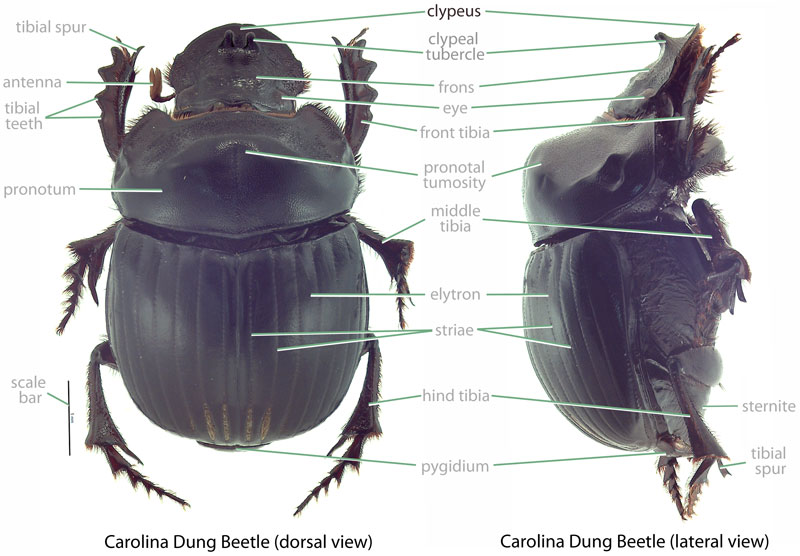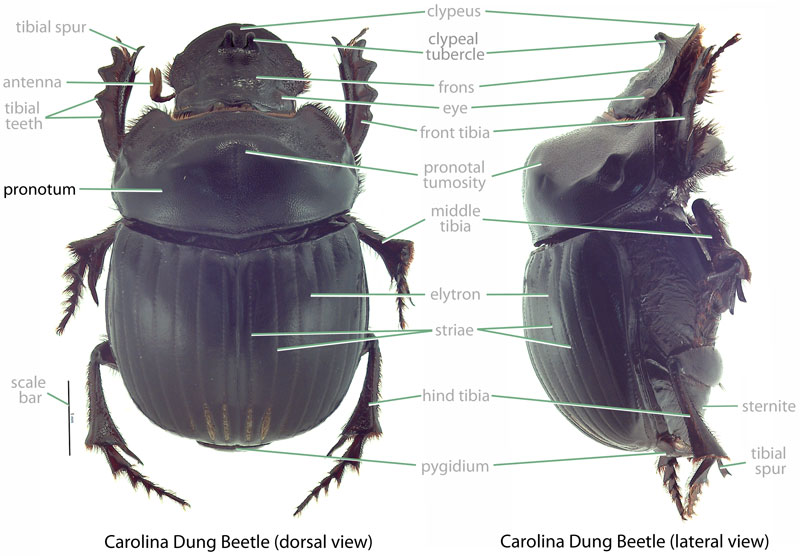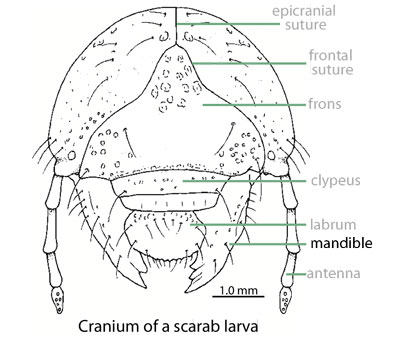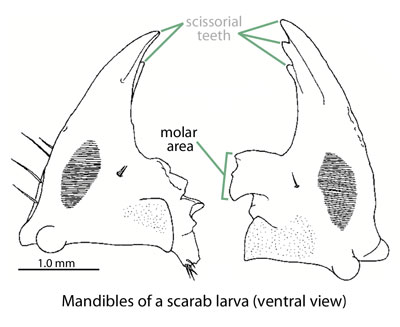Potential Invader
sugarcane beetle, sugarcane grub
Family: Scarabaeidae Subfamily: Dynastinae Genus: Tomarus Species: Tomarus subtropicus (Blatchley, 1922)
none available
Total body length 20.0–26.0 mm (0.79–1.02 in). Body oblong. Color shiny black. Clypeusclypeus:
part of the head anterior to the frons; the most anterior portion in dorsal view
 constricted towards parabolic apexapex:
constricted towards parabolic apexapex:
point or edge furthest from the body
; apexapex:
point or edge furthest from the body
with 2 close-set, apical teeth. Head lacking weak, transversetransverse:
extending horizontally across a surface
ridge on discdisc:
the central upper surface of any body part (e.g., pronotum, elytron, clypeus, frons)
; without horns or tubercles. Pronotumpronotum:
the dorsal surface of the thorax
 with small tubercletubercle:
with small tubercletubercle:
a small, conical knob or horn-like protuberance
near anterioranterior:
the front or forward; opposite of posterior
margin; distinct foveafovea:
a depressed pit or indentation
present behind apical tubercletubercle:
a small, conical knob or horn-like protuberance
. Apexapex:
point or edge furthest from the body
of last sternitesternite:
the ventral part of a thoracic or abdominal segment
 emarginated in male, quadratequadrate:
emarginated in male, quadratequadrate:
square-like in shape
in female.
For Tomarus (Ritcher, 1966Ritcher, 1966:
Ritcher P. 1966. White grubs and their allies: a study of North American scarabaeoid larvae. Oregon State University Monographs, Studies in Entomology 4: 1-219.): Grub C-shaped, not hump-backed, cylindrical, cream-colored. Maxilla with galea and lacinia fused or nearly so. Lacinialacinia:
inner portion of the maxilla of maxillamaxilla:
of maxillamaxilla:
set of paired mouthparts located posterior to the mandibles
with 3 well developed unci. Maxillary stridulatory teeth truncate. Inner, concave surface of mandiblemandible:
The crushing or chewing portion of an insects mouthparts
 , distaddistad:
, distaddistad:
oriented away from the body or the point of articulation with body
of molar areamolar area:
grinding area of the mandible, behind scissorial area
 , toothed. Dorsaldorsal:
, toothed. Dorsaldorsal:
of or relating to the upper surface; opposite of ventral
surface of the last antennal segment with 2–5 sensory spots. Legs 4-segmented. Anal opening straight or slightly curved. Plegmatia absent.
Southeastern U.S. This species is found from North Carolina south through Florida and east to Alabama (Buss, 2003Buss, 2003:
Buss E. 2003. Sugarcane grub. University of Florida, Featured Creatures. Available from http://entnemdept.ufl.edu/creatures/orn/turf/sugarcane_grub.htm (accessed 2015).).
In its native range, larvaelarvae:
the immature form of an insect; in scarabs, also called grub or white grub; preceded by the egg stage, followed by the pupal stage
 of this species are well-documented pests of sugarcane and turf grasses (Buss, 2003Buss, 2003:
of this species are well-documented pests of sugarcane and turf grasses (Buss, 2003Buss, 2003:
Buss E. 2003. Sugarcane grub. University of Florida, Featured Creatures. Available from http://entnemdept.ufl.edu/creatures/orn/turf/sugarcane_grub.htm (accessed 2015).). Kostromytska and Buss (2011) investigated the suitability of different turf grasses as larval host plants. They found that the warm season turf grasses including palmetto saint augustine grass (Stentaphrum secundatum), ‘tifway’ bermuda grass (C. dactylon x transvaalensis), ‘empire’ zoysia grass (Zoysia japonica), common centipede grass (Erimochloa ophiuroides),‘pensacola’ bahia grass (Paspalum notatum), and ‘sea dwarf’ seashore paspalum (Paspalum vaginatum) were all suitable hosts. However, larvaelarvae:
the immature form of an insect; in scarabs, also called grub or white grub; preceded by the egg stage, followed by the pupal stage
 failed to thrive on the cool season turf grasses including ‘gulf’ annual ryegrass (Lolium multiflorum).
failed to thrive on the cool season turf grasses including ‘gulf’ annual ryegrass (Lolium multiflorum).
In Florida, there is a single generation each year. Adults are active April through June, with numbers peaking in May and June when eggs are laid (Buss, 2003Buss, 2003:
Buss E. 2003. Sugarcane grub. University of Florida, Featured Creatures. Available from http://entnemdept.ufl.edu/creatures/orn/turf/sugarcane_grub.htm (accessed 2015).). The final instarinstar:
in scarabs, one of the three larval growth phases (i.e., first instar, second instar, third instar), each ending with the larvae molting to the next phase
is found from October to April. Pupation takes place in a subterranean pupal cell (Buss, 2003Buss, 2003:
Buss E. 2003. Sugarcane grub. University of Florida, Featured Creatures. Available from http://entnemdept.ufl.edu/creatures/orn/turf/sugarcane_grub.htm (accessed 2015).). Females of this species strongly prefer to lay eggs in "mucky" organic rich soils. LarvaeLarvae:
the immature form of an insect; in scarabs, also called grub or white grub; preceded by the egg stage, followed by the pupal stage
 are rarely found in sandy sites (Cherry and Coale, 1994Cherry and Coale, 1994:
are rarely found in sandy sites (Cherry and Coale, 1994Cherry and Coale, 1994:
Cherry R and Coale F. 1994. Oviposition of the sugarcane grub, Ligyrus subtropicus (Coleoptera:Scarabaeidae) in different soils. Journal of Economic Entomology 11: 345-348.).
Significant. LarvaeLarvae:
the immature form of an insect; in scarabs, also called grub or white grub; preceded by the egg stage, followed by the pupal stage
 of this species are serious and destructive pests of grasses (Buss, 2003Buss, 2003:
of this species are serious and destructive pests of grasses (Buss, 2003Buss, 2003:
Buss E. 2003. Sugarcane grub. University of Florida, Featured Creatures. Available from http://entnemdept.ufl.edu/creatures/orn/turf/sugarcane_grub.htm (accessed 2015).). In Florida, Tomarus subtropicus is the single most important scarab pest of sugarcane and is able to reduce yields by more than a third (Cherry and Coale, 1994Cherry and Coale, 1994:
Cherry R and Coale F. 1994. Oviposition of the sugarcane grub, Ligyrus subtropicus (Coleoptera:Scarabaeidae) in different soils. Journal of Economic Entomology 11: 345-348.). The species also damages a variety of turf grasses (Kostromytska and Buss, 2011Kostromytska and Buss, 2011:
Kostromytska O and Buss E. 2011. Tomarus subtropicus (Coleoptera: Scarabaeidae) larval feeding habits. Florida Entomologist 94: 164-171.).
Not established or recorded. There are no records of this species from Hawaii.
Not established or recorded. There are no records of this species from Guam.
Because larvaelarvae:
the immature form of an insect; in scarabs, also called grub or white grub; preceded by the egg stage, followed by the pupal stage
 feed on turf roots, it is possible that larvaelarvae:
feed on turf roots, it is possible that larvaelarvae:
the immature form of an insect; in scarabs, also called grub or white grub; preceded by the egg stage, followed by the pupal stage
 or eggs could be transported in shipments of commercial turf. Other Tomarus species are known to fly to lights at night (Ratcliffe and Paulsen, 2008Ratcliffe and Paulsen, 2008:
or eggs could be transported in shipments of commercial turf. Other Tomarus species are known to fly to lights at night (Ratcliffe and Paulsen, 2008Ratcliffe and Paulsen, 2008:
Ratcliffe B and Paulsen P. 2008. The scarabaeoid beetles of Nebraska (Coleoptera: Scarabaeoidea). Bulletin of the University of Nebraska 22: 138-248.), and it is likely that this beetle is attracted to well-lit ports and airports. This would allow for hitchhiking on marine and air cargo.
This species is similar to the carrot beetle (Ligyrus gibbosus) recorded on Oahu and the potential future invaders, the taro beetles (Papuana spp.). It can be separated from those scarabs by examination of the head (T. subtropicus without horns or tubercles versus Papuana spp. that often possess horns or tubercles), central discdisc:
the central upper surface of any body part (e.g., pronotum, elytron, clypeus, frons)
of the head (T. subtropicus lacking a transversetransverse:
extending horizontally across a surface
ridge versus a weak, transversetransverse:
extending horizontally across a surface
ridge in L. gibbosus), clypealclypeal:
of, or referring to, the clypeus
apexapex:
point or edge furthest from the body
(T. subtropicus clypeusclypeus:
part of the head anterior to the frons; the most anterior portion in dorsal view
 constricted with 2 close-set apical teeth versus clypeusclypeus:
constricted with 2 close-set apical teeth versus clypeusclypeus:
part of the head anterior to the frons; the most anterior portion in dorsal view
 broad, never with 2 close-set apical teeth in Papuana spp.), color (T. subtropicus is shiny black versus reddish-brown in L. gibbosus), and size (T. subtropicus is 20.0–26.0 mm [0.79–1.02 in] versus L.. gibbosus at 11.6–16.5 mm [0.46–0.65 in]).
broad, never with 2 close-set apical teeth in Papuana spp.), color (T. subtropicus is shiny black versus reddish-brown in L. gibbosus), and size (T. subtropicus is 20.0–26.0 mm [0.79–1.02 in] versus L.. gibbosus at 11.6–16.5 mm [0.46–0.65 in]).
Ligyrus subtropicus Blatchley
In Hawaii, this species represents a new invasiveinvasive:
a species that has recently arrived to a new location, usually via human activity, causing notable economic and/or ecological damage
species. Prevent the spread of this species by reporting your observation at our iNaturalist project.